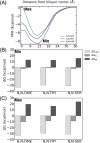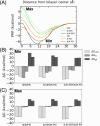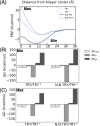Membrane Permeation of Psychedelic Tryptamines by Dynamic Simulations
- PMID: 38324395
- PMCID: PMC10882957
- DOI: 10.1021/acs.biochem.3c00598
Membrane Permeation of Psychedelic Tryptamines by Dynamic Simulations
Abstract
Renewed scientific interest in psychedelic compounds represents one of the most promising avenues for addressing the current burden of mental health disorders. Classic psychedelics are a group of compounds that exhibit structural similarities to the naturally occurring neurotransmitter serotonin (5-HT). Acting on the 5-HT type 2A receptors (HT2ARs), psychedelics induce enduring neurophysiological changes that parallel their therapeutic psychological and behavioral effects. Recent preclinical evidence suggests that the ability of psychedelics to exert their action is determined by their ability to permeate the neuronal membrane to target a pool of intracellular 5-HT2ARs. In this computational study, we employ classical molecular dynamics simulations and umbrella sampling techniques to investigate the permeation behavior of 12 selected tryptamines and to characterize the interactions that drive the process. We aim at elucidating the impact of N-alkylation, indole ring substitution and positional modifications, and protonation on their membrane permeability. Dimethylation of the primary amine group and the introduction of a methoxy group at position 5 exhibited an increase in permeability. Moreover, there is a significant influence of positional substitutions on the indole groups, and the protonation of the molecules substantially increases the energy barrier at the center of the bilayer, making the compounds highly impermeable. All the information extracted from the trends predicted by the simulations can be applied in future drug design projects to develop psychedelics with enhanced activity.
Conflict of interest statement
The authors declare no competing financial interest.
Figures









References
-
- Shulgin A. T.; Shulgin A.. PIHKAL: A Chemical Love Story; Transform Press: Berkeley, CA, 1991; Vol. 963009605.
LinkOut - more resources
Full Text Sources

